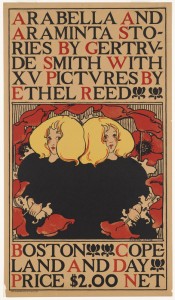



American companies took notice when French art posters became extremely popular in the 1880’s. A new lithography process had made economical printing of large editions of posters possible. American companies commissioned prominent illustrators like Edward Penfield, Will Bradley, Ethel Reed and Maxfield Parrish to create posters. There is no denying the purpose of the posters was to advertise performances, exhibits, magazines, books and other products to a growing middle class. If it also brought art to everyday life, so much the better. And so the American Art Poster entered its golden age, 1890-1920.
Edward Penfield’s poster advertising the April 1893 Harper’s magazine (above, far left) is generally credited as starting an American poster revolution. Unlike previous American posters, this one advertised intellectual – not commercial – product. It also was much more restrained and simpler than the French posters of the time. Penfield included his monogram on this poster. Later, Penfield and the other illustrators would sign their full names and printers would add their company names. Penfield’s posters also set the precedent of doubling as magazine (or book) covers.
Will Bradley’s beautiful Art Nouveau peacock (above, center left) is a change from his frequent depictions of women in windblown gowns. However, it demonstrates the color intensity and textural effects possible with the new lithographic process. This image also demonstrates the influence of Japanese block printing on the Boston-born Bradley.
The always fascinating Ethel Reed was born in Newburyport, studied art in Boston and became a leading poster artist before leaving for London. While still in Boston, she did illustrations for the local newspapers and a guide to Boston as well as book covers, like the Arabella and Araminta stories. (above, center right)
Maxfield Parrish’s Daybreak painting would go on to become the most popular art print of the 20th century. In contrast to the saturated colors of his paintings, Parrish started out with black and white commercial art. Some of those ads and Harper’s Weekly covers are here. The charmingly domestic Harper’s Weekly Christmas cover (above, far right) includes a color background for its black and white image.
With over 500 images, the Boston Public Library’s American Art Posters 1890-1920 is a collection you can visit and revisit, discovering new favorites each time.